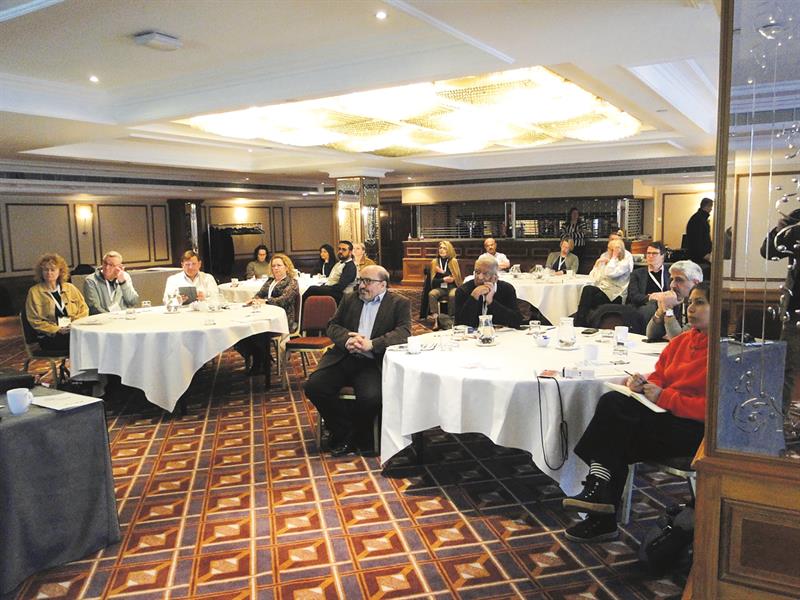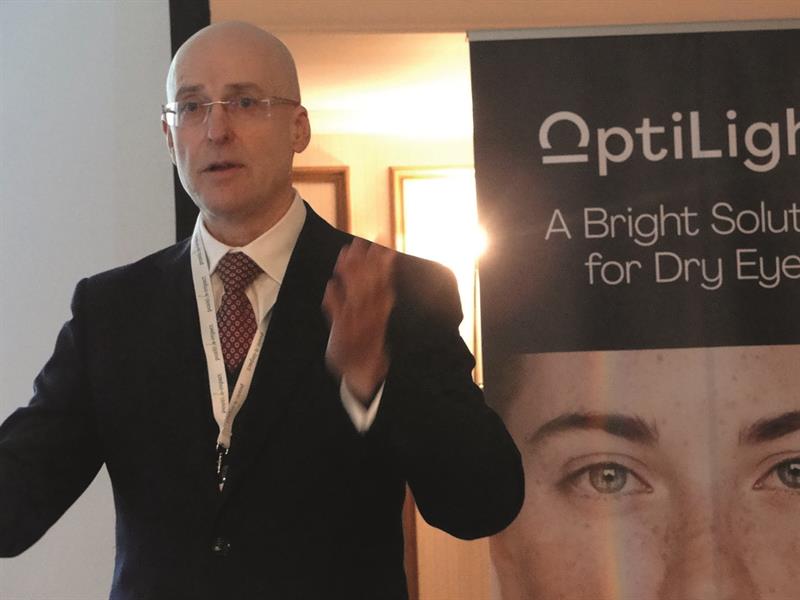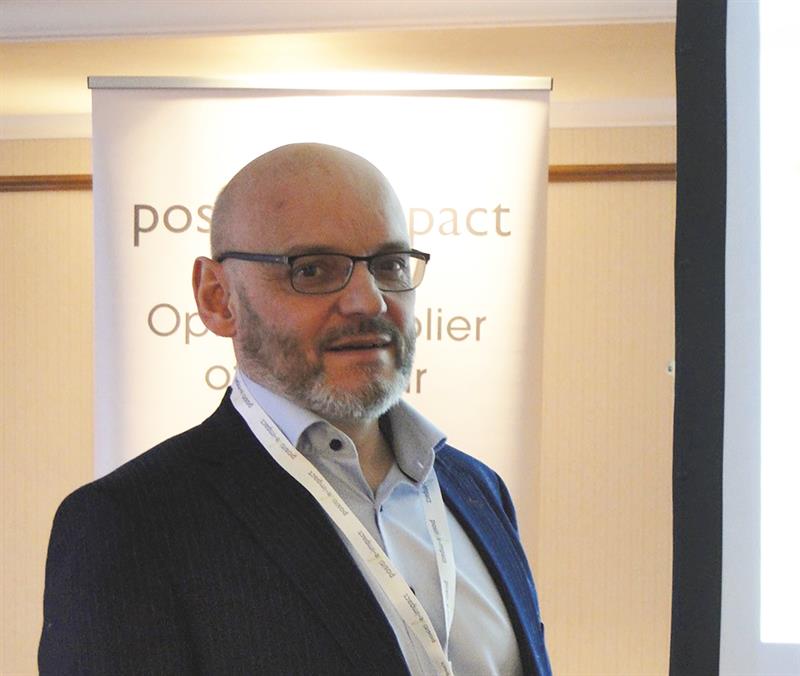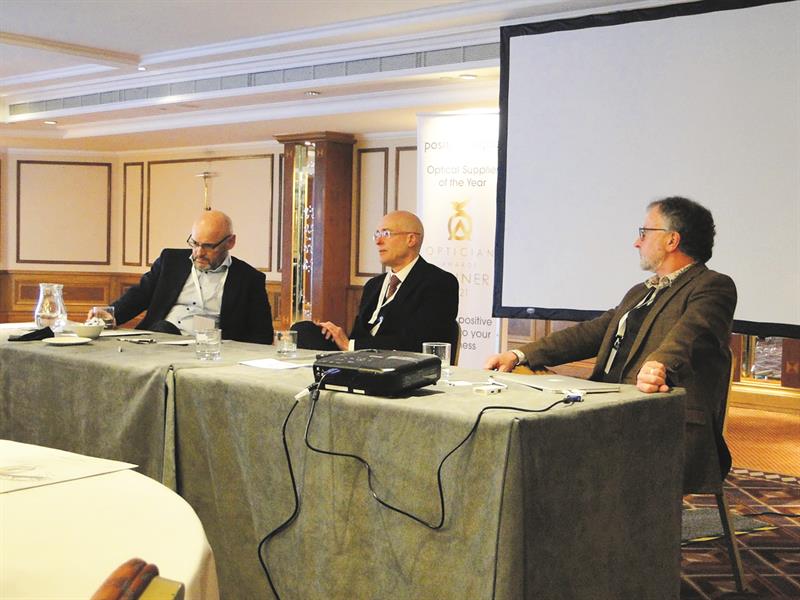
Despite several delayed starts due to Covid-19 and then a closure on the M6 on the day, our profession would not be thwarted and the one-day Specialist Club event took place at the National Motorcycle Museum in Birmingham. Attendees were rewarded with a packed agenda.
The event was titled New Front Tears: Techniques and Technologies for Dry Eye and, as suggested, was focused on the latest thinking around dry eye diagnosis and management. It was sponsored by organisers Positive Impact (Optician Magazine Awards – Optical Supplier of the Year 2021), TearLab, Topcon and Lumenis.
Establishing a successful Dry Eye Clinic
Optometrist and BCLA Dry Eye Practitioner of the Year, Nick Dash, opened the proceedings (figure 1). Nick has a proven track record of establishing and working in dry eye clinics and, along with ophthalmologist Guy Smith, is currently one of the founders of the Matrix Eye Clinic.
To fully appreciate how impactful dry eye is for sufferers, Nick shared information on a quality-of-life study that looked at how many years of life a patient would trade to be free of a serious condition. Considered this way, dry eye sits up there with angina and renal dialysis and so should not be underestimated. It is strongly associated with anxiety and depression and at best is impactful on productivity. This seemed quite remarkable but then if we think about it most chronic conditions start as a niggle that slowly but surely starts to affect health, comfort and happiness of that individual then this quality-of-life survey really is not that surprising. To think our profession has the ability to positively affect the expected trajectory of a disease is quite humbling. As Nick pointed out, dry eye disease management is not really what ophthalmologists want to do, ‘it’s not sexy’ was his actual quote whereas optometrists and contact lens opticians are ideally set to manage this disease effectively.
He then deciphered what a dry eye consultation looked like by moving through the different levels a practice can offer; from a basic level, through more advanced management and, ultimately, a more specialist clinic. He described how a basic level consultation had perhaps some level of slit lamp inspection, counting for tear break up time and recommending drop and lid cleaning therapies.
Moving on to an advanced level, where ECPs are now starting to use questionnaires and dedicated equipment, such as imaging, for diagnosis and offering in-practice treatments such a NuLids or BlephEx eyelid cleaning. Finally, a practice might move on from the advanced stage to develop a more specialist dry eye clinical practice, with the introduction of better diagnostic equipment to improve understanding of the ‘health’ of the ocular surface, such as using TearLab to measure severity using osmolarity and InflammaDry testing to assess the level of ocular surface inflammation present. Using these kind of metrics builds a strong picture of what is going on, enabling better targeted management, such as anti-inflammatory treatments or, at the very specialist level, intense pulse light therapy (IPL).
Nick made a very good point about metrics by emphasising that their power is not to be underestimated. Measuring is what we all recognise and do all day long, and better measurement in dry eye practice gives us a sense of the calibration of success. With that said, it is important to not run before walking. So, he advised practitioners to build their confidence slowly, and to recognise that it is the combination of knowledge, equipment and clinic as being the key to success.
Lifting the lid on Periocular Care
The second lecture was a discussion session (figure 2) led by contact lens optician and experienced dry eye practitioner, Ros Mussa. Ros gave an interesting insight into the lack of information available to patients with regard to the importance of the tear film. Everyone uses Google, and yet searching for images of the eyes usually first leads to photos and diagrams of the eye showing a variety of details; the globe, ocular media, retina, crystalline lens, pupil and cornea, but no depiction of the tear film. So, from a patient perspective, how important is the tear film and is it really the cause of the problems being presented?

Figure 2: Discussion session under way
Ros looked back to the past where, before the first TFOS DEWS 1 was published in 2007, dry eye was considered as a syndrome and only since has it been recognised as a disease which needs to be treated. Ideally, it should be treated before symptoms and outcomes become too far advanced. Maintaining homeostasis is key, and Ros used the analogy of putting on a coat before we get cold rather than waiting until we are cold, as easily understandable to a patient whereby using their drops before their eyes feel dry would be the best course of action, thereby maintaining homeostasis before it starts to break down.
Ros then went on to discuss the most common anterior eye conditions seen in practice, the prevalence of blepharitis and meibomian gland dysfunction (MGD) and the current go-to treatment strategies. Moving on to a discussion of our eight-clawed ‘friend’ Demodex, the speaker noted the role Demodex has to play in the prevalence of blepharitis and MGD when the ocular surface is infested with these mites. The issues Demodex cause are often not recognised or misdiagnosed resulting in poor management strategy and unsatisfied symptomatic patients. This further emphasised the importance of expanding our treatments regimes to include terpinen-4-ol (T4O) and hypochlorous solutions, as well as micro-debridement. She went on to explain the difference between tea tree oil (TTO) based products, that contain T4O, and products that contain extracted T4O. T4O has a greater miticidal effect than TTO alone with less irritation. In vitro studies have shown that 10% concentration T4O kills mites in 15 minutes as compared to 145 minutes with 10% TTO. Importantly, if a product contains 5% TTO, then it contains approximately 1.5% T4O. This is not adequate enough to break the reproductive cycle of Demodex.
The Intense Pulse Light Therapy Opportunity
After a short break, Craig Wilcox (figure 3) gave an engaging talk on intense pulse light (IPL) and, in particular, his experience of using the therapy in his practice. Craig is an optometrist with a house practice on the south coast of England specialising in dry eye therapies. He has also developed formulations for dye eye management, such as his DemEx foaming cleanser, and heavily invested in specialist equipment to treat dry eye.
His talk, ‘Think outside the eye – how to get ahead of the curve in optometry,’ looked at a different approach to how we tackle dry eye. Craig looked at what cannot be commoditised, such as our service and expertise, and explained that, in his view, the future should be built around treatment procedures, such as BlephEx/Nulids and other in-practice techniques such as IPL.
He encouraged delegates to ‘look at the person’, ie the bigger picture, and to encourage and empower our teams to be able to do the same. He also introduced hyperkeratinisation, a new term for many, which leads to physical changes of the meibomian gland ductal epithelium. This causes a decrease in glands, ductal plugging and gland atrophy.

Craig then treated us an interesting insight into his successes using IPL, from the earlier models through to one of the newest and, in his view, most advanced currently on the market; namely, the OptiLight from Lumenis. It is the first and only IPL approved by the FDA in the US. He spoke of the importance of understanding the nature of the skin and how this can impact on the successful outcome of treatment. This is helped, he explained, by the OptiLight’s ability to use incoherent light (from 400 to 1,200nm) to give a more effective and focused treatment.
Sponsors ‘show and tell’
Either side of lunch were several short commercial presentations from the day’s sponsors. Danielle Lee (from Topcon) gave a tour of the Myah, an interesting device that combines topography and biometry for axial length measurement with a suite of dry eye analytics, including non-invasive TBUT capable of mapping the break-up areas as well as meibography for the assessment of gland functionality.
Paris Hatzianastasiadis (from Lumenis) gave an insight into the expansive capabilities of the OptiLight IPL, the research behind it and how to monetise the treatments it can give. Next, Positive Impact’s new professional services director, Phil Thompson, covered the dry eye ‘Circle of Care’; the company’s fresh approach to the supporting independent dry eye practitioners in advising patients on what products to use and how and when to use them, to help improve outcomes. He explained how the curation of the Dry Eye Zone product range has created a ‘virtuous’ circle of care.
Last but not least, event organiser Nick Atkins discussed his proposition that ‘simply counting to 10’ and adding a ‘drop of dye’ really is not cutting it in a modern dry eye practice. He showed how the TearLab osmolarity system is the gold standard in the diagnosis of dry eye, supported by more peer reviewed papers than any other similar device, confirming its accuracy, sensitivity and specificity. Indeed, he went on, TearLab osmolarity measurements have been shown to be 89% predictive of dry eye disease, as important in ruling out dry eye as it is ruling it in.
Is there something fishy about Dry Eye?
The day was rounded off by Keynote speaker, Professor Jonathan (Johnny) Moore from the Cathedral Eye Clinic, Belfast (figure 4); an ophthalmologist who, like Craig Wilcox, has found himself formulating a dry eye treatment as a result of his frustration with what was currently available. In this case, the Eye Nutrients Dry Omega range of liquid and capsules. His talk offered a fascinating insight into some unique properties of meibum and an in-depth review of the component properties of dry eye disease.
Professor Moore was also able to give an insight into pre-operative care that impacts on successful post-operative outcomes. He highlighted assessment techniques, including TearLab and InflammaDry, as well as other aspects of ageing and the influence therein.

He further described the post-operative loss of corneal sensitivity leading to reduced blink rate and explained how this has a detrimental influence on the success of procedures. It is a vicious cycle that can be controlled and broken. He gave an insight into corneal procedures such as LASIK and SMILE, as well as IOL implantation, and showed how these needed to be managed for dry eye pre and post-operatively. He then discussed hyperkeratinisation and the need for treatment.
Finally, he gave an interesting insight on the importance of essential fatty acids, from his unique perspective, having been involved in the development of Eye Nutrients. He said an ideal product needs to be made from pure and natural fish oils, so it contains natural triglycerides. Oxidation is the enemy here, as that creates the fishy smell and taste. He was critical of the DREAM study, a widely publicised study that delivered headlines giving the perception that omega-3 has little value in dry eye management, for using a poor control in olive oil, something that is known to be beneficial to the body and the eye. He explained that this threw doubt over the conclusion of the study and shared references of many other studies that support the use of omega-3. Like many products, it is the quality of the ingredients and the formulation that is paramount in delivering results.
Success
The day ended with a panel of speakers taking questions (figure 5). It was clear that all participants seemed to have enjoyed the event, as much for finally being together with colleagues again as the excellent programme. There was also much support for the next club meeting, later in the year, being focused on myopia and its management.
Watch this space for details.

- Phil Thompson is a contact lens optician and Professional Services Director of Positive Impact.
- Ros Mussa is a contact lens optician with a special interest in ocular surface disease.
